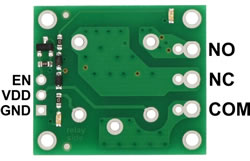The Pololu basic relay carrier modules allow simple control of a single-pole, double-throw (SPDT) switch from low-voltage, low-current control signals.
This item includes the basic carrier PCB along with an Omron G5LE-14-DC5 5 V relay, 5.0 mm terminal blocks, and 0.1" male headers in straight and right-angle versions.
Surface-mount components are pre-assembled on the PCB, but the through-hole components are not installed.
Advantages over similar products
- Compact layout
- Two LEDs to indicate coil actuation
- Zener diode for fast current decay on relay coil
- Specification of electrical routing clearance rules on relay switch nodes
Using the relay module


The switch portion of the relay is accessible on one side of the board while the control pins are routed to the other. The relay coil is powered by supplying 5 V or 12 V across the VDD and GND pins (depending on the relay), and it is activated by a digital high control signal on the EN pin. The control signal is fed directly to a BSS138 N-channel MOSFET, which in turn actuates the relay coil when the control voltage exceeds approximately 2.5 V (see BSS138 datasheet (92k pdf) for details).
The relay switch terminals COM (common), NO (normally open), and NC (normally closed) are routed on the PCB with a minimum clearance of 60 mils (1.5 mm) from other copper. The copper traces are designed to be at least 45 mil (1.1 mm) from the board edges, though manufacturing variations in the board edges can make those distances slightly lower.
In most applications, the current and voltage ratings for the module will match the ratings of the relay used. Maximum current, maximum voltage, and life expectancy are interdependent; we therefore recommend careful examination of your relay’s datasheet.
Warning: This product is not designed to or certified for any particular high-voltage safety standard. Working with voltages above 30 V can be extremely dangerous and should only be attempted by qualified individuals with appropriate equipment and protective gear.







